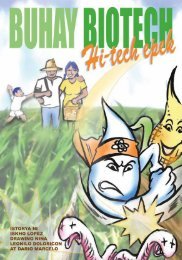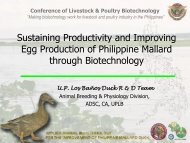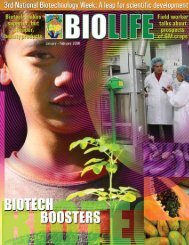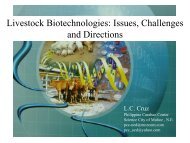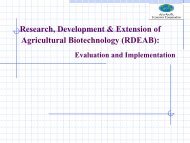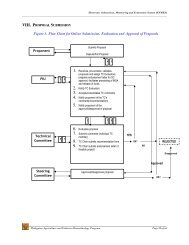Download PDF - SEARCA Biotechnology Information Center
Download PDF - SEARCA Biotechnology Information Center
Download PDF - SEARCA Biotechnology Information Center
Create successful ePaper yourself
Turn your PDF publications into a flip-book with our unique Google optimized e-Paper software.
January – March 2005 BIO LIFE<br />
25<br />
A MICROBIOLOGIST working at<br />
the Biotech Lab Unit of the<br />
National Meat Inspection Services<br />
(left), while Dr. Cynthia Nalo-<br />
Ochona (below) extracts RNA from<br />
a tissue culture of an animal<br />
disease virus. At right, Dr. Ochona<br />
slices a bovine brain for BSE or<br />
“mad cow” disease testing.<br />
been detected in the country. One of the diseases<br />
given priority attention in the project is<br />
the Infectious Laryngotracheitis (ILT) which<br />
affects poultry. It is an acute viral disease of<br />
mature chickens, pheasants and peafowl, affecting<br />
the respiratory system.<br />
The disease has been reported and<br />
documented to be present in the country.<br />
Outbreaks of ILT have recently been occurring<br />
in the provinces of Batangas,<br />
Bulacan, Pampanga, Nueva Ecija and<br />
Bacolod with reports of 30-40 percent mortalities<br />
in pullets.<br />
“Namamatay ang mga manok; and at<br />
the time that they are ready to lay eggs, that’s<br />
when they die,” laments Dr. Morales, who<br />
describes ILT as a reemerging disease in<br />
the Philippines. The chickens die even before<br />
they lay eggs. The disease has been<br />
discovered to be concentrated in Batangas,<br />
Bataan, Nueva Ecija and Pampanga. It is<br />
concentrated in Batangas and Pampanga,<br />
which is the egg basket of the Philippines.<br />
“We have to stop the disease even before<br />
it spreads in other parts of the country,<br />
so [there must be] support [for] the modern<br />
biotechnology methods of detecting the disease”<br />
said Morales.<br />
The traditional method of detecting ILT<br />
is very slow, tedious and expensive. The<br />
faster, reliable, specific and more accurate<br />
method of detecting the viral agent is through<br />
the use of DNA-based techniques, whereby<br />
not only the ILT virus is detected but also<br />
the type and strain present. These are important<br />
considerations for an effective and<br />
appropriate vaccination, control, and disease<br />
prevention.<br />
The group also conducts tests to develop<br />
more accurate and specific tools for the control,<br />
prevention and eradication of Hog Cholera,<br />
a highly contagious disease affecting<br />
pigs and wild boar. This has caused major<br />
economic loss in the global pig industry.<br />
Meanwhile, Dr. Ochona has just finished<br />
conducting safety and feeding trials on the<br />
use of BT corn on pig. The initial result is<br />
that the pigs which eat BT corn are fatter.<br />
More results will soon come out.<br />
Morales, who has been in the Bureau<br />
for 30 years, believes that a more supportive<br />
government and civil society is crucial to<br />
their success. “Twenty years ago, the Philippines<br />
used to be at the top in terms of advancing<br />
biotechnology among Asian countries;<br />
now we are lagging behind. Let us not<br />
waste the opportunities,” she stresses.




